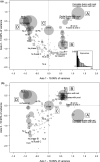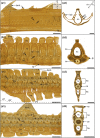Phenotypic regionalization of the vertebral column in the thorny skate Amblyraja radiata: Stability and variation
- PMID: 34542171
- PMCID: PMC8742970
- DOI: 10.1111/joa.13551
Phenotypic regionalization of the vertebral column in the thorny skate Amblyraja radiata: Stability and variation
Abstract
Regionalization of the vertebral column occurred early during vertebrate evolution and has been extensively investigated in mammals. However, less data are available on vertebral regions of crown gnathostomes. This is particularly true for batoids (skates, sawfishes, guitarfishes, and rays) whose vertebral column has long been considered to be composed of the same two regions as in teleost fishes despite the presence of a synarcual. However, the numerous vertebral units in chondrichthyans may display a more complex regionalization pattern than previously assumed and the intraspecific variation of such pattern deserves a thorough investigation. In this study, we use micro-computed tomography (µCT) scans of vertebral columns of a growth series of thorny skates Amblyraja radiata to provide the first fine-scale morphological description of vertebral units in a batoids species. We further investigate axial regionalization using a replicable clustering analysis on presence/absence of vertebral elements to decipher the regionalization of the vertebral column of A. radiata. We identify four vertebral regions in this species. The two anteriormost regions, named synarcual and thoracic, may undergo strong developmental or functional constraints because they display stable patterns of shapes and numbers of vertebral units across all growth stages. The third region, named hemal transitional, is characterized by high inter-individual morphological variation and displays a transition between the monospondylous (one centrum per somite) to diplospondylous (two centra per somite) conditions. The posteriormost region, named caudal, is subdivided into three sub-regions with shapes changing gradually along the anteroposterior axis. These regionalized patterns are discussed in light of ecological habits of skates.
Keywords: Amblyraja radiata; axial regionalization; elasmobranchs; evolution; vertebral column.
© 2021 Anatomical Society.
Conflict of interest statement
The authors declare that they have no conflicts of interests.
Figures






References
-
- Arratia, G. , Schultze, H.‐P. & Casciotta, J. (2001) Vertebral column and associated elements in dipnoans and comparison with other fishes: development and homology. Journal of Morphology, 250(2), 101–172. - PubMed
-
- Aschliman, N.C. , Claeson, K.M. & McEachran, J.D. (2012) Phylogeny of batoidea. In: Carrier, J.C. , Musick, J.A. & Heithaus, M.R. (Eds.) Biology of sharks and their relatives, 2nd edition. Boca Raton: CRC Press, pp. 57–95.
-
- Berio, F. , Broyon, M. , Enault, S. , Pirot, N. , López‐Romero, F.A. & Debiais‐Thibaud, M. (2021) Diversity and evolution of mineralized skeletal tissues in chondrichthyans. Frontiers in Ecology and Evolution, 9, 223.
-
- Bird, N.C. & Mabee, P.M. (2003) Developmental morphology of the axial skeleton of the zebrafish, Danio rerio (Ostariophysi: Cyprinidae). Developmental Dynamics, 228(3), 337–357. - PubMed
Publication types
MeSH terms
LinkOut - more resources
Full Text Sources

